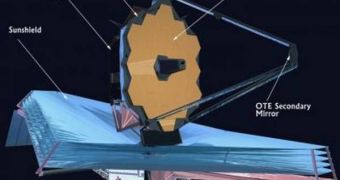Despite the fact that most contractors and science teams hired by NASA to design and implement the instruments on the new James Webb Space Telescope (JWST) are still in the early phases of development, experts at the agency have recently devised a new 3D model of how the craft will unfold once it reaches its L2 orbit point. The James Webb will be so massive that there is currently no way of transporting it to orbit in its unfolded configuration.
The model is very important for those working on the project, because they now know approximately what the final configuration will look like. The designs are naturally prone to modifications, and will probably undergo a large number of changes until the American space agency deems the device ready to fly, but the developers need to get a better idea of how their work will look like. In addition, the new 3D model also reveals that certain instruments will have to be very carefully positioned, so as not to interfere with the various moving parts of the telescope, during its deployment.
“Animation helps designers and their colleagues to fully visualize and explain the complex motions required to deploy this observatory. And while it's a visual tool, producing accurate animation is a technical challenge as well,” Mike Herriage, who is the deputy program manager for the JWST, said. He is working for Redondo Beach, California-based aerospace company Northrop Grumman, experts of which were the main creators of the new animation as well.
“There are videos showing a simple deployment and a version that includes detailed views of key points in the sequence. There are 2- and 4-megabyte versions of each video and they are high definition,” Mark Clampin added. Working from NASA's Goddard Space Flight Center, in Greenbelt, Maryland, the expert is the project scientist for the Webb Telescope Observatory. He explained that the only option for deploying the JWST was to fold it, and then somehow fit it inside an existing rocket. Once it reaches its orbit, it can unfold and commence observations.
The infrared orbiting observatory is currently scheduled to be launched no early than June 2013, aboard an Ariane 5 delivery system. The rocket will most likely take off from the European Space Agency's Guiana Space Centre Kourou, in the French Guiana, South America. It will operate in the 0.6-to-28-micrometer-wavelength range, in order to be able to peer through large amounts of cosmic dust and gases. Because of its infrared nature, the entire telescope will have to operate in a somewhat cool environment, at roughly 40°Kelvin (−233.15°C or −387.67°F).

 14 DAY TRIAL //
14 DAY TRIAL //